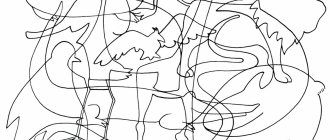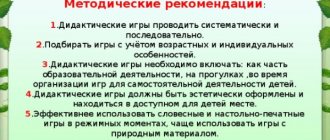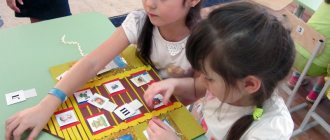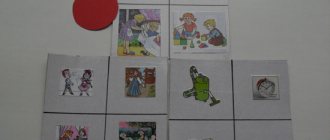Didactic games and exercises to develop attention for preschool children. A selection of the most exciting and effective ideas.
Attention is one of the most important higher mental functions. Teaching a child to concentrate and maintain attention is one of the main tasks of preschool education, which parents usually have to solve.
There are always many signals around us. And children's minds respond to them more easily than adults, making it difficult to focus on something specific (and important).
The best way to work on children's attention is through play. This is the most effective and fun way to have fun and achieve optimal success in developing attention.
Games to develop attention in children
Construction
One of the best concentration exercises for children is to build structures using different types of parts. From regular bricks to classic Lego blocks, from a magnetic construction set to a flexible track.
As the child gets older, the designs will become more complex. All you have to do is choose the one that is most suitable for the age and development level of each child.
Offer different games that require boys and girls to place tiles in a certain way.
The very fact of superimposing one part on another requires a lot of concentration, which improves both mental abilities and fine motor skills of the hands. This is more than just a game, it is one of the best games for developing attention in children.
Making puzzles
Another concentration game for kids is solving puzzles. There are puzzles adapted to the child's age, with more or fewer pieces, using different materials and sizes of pieces.
Assembling a puzzle is not just a game. This is a very good concentration training for children.
You don't have to buy puzzles. You just need to cut out or print a beautiful image and cut it into several pieces of different shapes so that you can put them together later.
And remember, adults can benefit from continuing to train their brains every day too!
Memory
Another game that requires attention, and which you can easily do at home, is memory. When choosing different designs or images that relate to each other, make several tiles that can be separated to put them back together.
Or you can print the pictures. Link to free memory at the end of the article.
The game consists of mixing and matching cards with a matching pair. You can connect identical pictures or connect animals with the environment in which they usually live.
Coloring by numbers
To color the entire drawing, children will have to focus all their attention on the assigned numbers and colors. Free coloring by numbers at the link at the end of the article.
Finding differences
This game is useful for developing selective attention. You can work with “Find the Differences” pictures (link to free ones is also at the end of the article), with online games to find the differences, or make a game from scrap materials.
For example, you can take two large plates, place objects on them and look for the difference. Or play with one set of objects and determine “what has changed.”
Looking at Wimmelbooks
Wimmelbooks are interesting picture books with many small details. The most popular Wimmelbooks in the world:
- seasonal wimmelbooks by Susanne Berner,
- picture books for children by Lila Leiber,
- wimmelbook quest about detective Pierre,
- "Where's Wally?" - a popular series of Wimmelbooks by Martin Handford,
- beautiful wimmelbook about nature Henkel.
What changed?
The last of the proposed games for attention and memorization is also very easy to perform. You can play anywhere, with many different items and, if necessary, increasing the difficulty level.
The game is to collect a set of different objects that are not related to each other and place them on a table or floor. The child will have to remember everything, concentrating as much as possible. Then the child will close his eyes, and one of the objects must be removed. If the child answers that he is absent, he wins!
Another game option for training attention is to exchange one object for another or even put them in a row to change the order in which they were located.
Life story
My close friends have a son, now he is almost 7 years old. He was initially a difficult child, hyperactive, absent-minded, extremely active and restless. His mom and dad were horrified at the thought that they would have to deal with their son somehow.
The baby did not like to listen to books, and in general was very naughty. But, lo and behold, he behaved wonderfully in developmental classes in the garden! The kid coped with any task, he had enough perseverance and stability to finish everything to the end.
Perhaps it was the atmosphere. Or, in the company of peers, the baby behaved better. The parents were surprised at first. Then they started studying at home. Now the boy is doing well at school and directs his energy to sports activities.
Print exercises to develop attention for children
Below are links to materials on the same site, by clicking on which you can download and print exercises for developing attention in children for free.
- attention tasks for children,
- games for developing a child's memory,
- exercises to find the differences,
- children's cutting puzzles,
- coloring by numbers,
- tasks find the shadow,
- exercises find identical pictures,
- print memory cards,
- various tasks to develop attention for children,
- find-and-find for children,
- find and count colored tasks,
- mazes for children,
- graphic dictations by cells,
- graphic patterns by cells,
- article on the development of attention in children using sensory methods: listening, visualization, kinesthetics,
- article about the development of observation in children and visual discrimination.
What games do you use to develop attention in children?
How to develop your attention: a few general rules
Give yourself extra motivation
Before you begin work that requires distribution or switching of attention, tell yourself that at the moment you are not as interested in anything as in this matter. Think about what you will get after you achieve your goal. Think about how you will reward yourself for the results achieved.
Drink plenty of water
Three years ago, the journal Nutrition published the results of a study that experimentally proved that a lack of water in the body leads to deficits and minor attention disorders. In order to provide the body with the right amount of water, scientists recommend that women drink 9 cups daily, and men - 12.5.
Manage secondary tasks
On average, an office worker checks his email and Facebook pages up to 30 times every day. To focus on the task at hand, close all unnecessary tabs and determine a schedule for working with mail that is convenient for you:
- How many times will you open it?
- how much time will it take to spend on it?
Make a list of ways you are hindering yourself.
Psychologists at the American State University of Carolina, while tracking productive periods of work among office employees, unexpectedly found out that 44% of interruptions or unreasonable distractions were caused by the employees themselves. In the sense that no one bothered them, did not distract them from their work, did not make noise around them. The employee himself is the cause of almost half of his unjustified distractions from work
Unstable attention is the reason
Researchers point to countless reasons why people get distracted. But no one can name these reasons for you. Therefore, my advice is to choose a time and write down all your personal internal provocations for attention problems. Among them may be:
- thirst and hunger;
- desire to smoke;
- lack of sleep;
- fatigue;
- your personal stress.
Now you need to figure out exactly when these reasons appear in your life and think through preventive measures accordingly.
Sometimes, as strange as it may sound, you still have to be able to ignore
It happens that a bright picture catches your eye. This is especially dangerous when you are driving. Conscious and effective distribution of attention assumes that objects fall into the field of activity of your consciousness because they are connected with your goal, and not at all because they cause unexpected and strong emotions such as:
- astonishment;
- curiosity;
- involuntary interest;
- confusion.
People, in particular, pay for their inability to “not pay attention” by wasting time on attractive advertising. But in European countries, the ingrained practice of men and women being in a bathhouse together and no one bothering anyone is based on the ability to “not pay attention”
But in European countries, the ingrained practice of men and women being in a bathhouse together and no one bothering anyone is based on the ability to “not pay attention”
Embrace a culture of breaks
Breaks have a kind of refreshing effect. Gradually, the eye seems to “blur”, and details begin to slip away from your field of vision. By returning to the task at hand, you can look at everything with renewed eyes. Psychologist Alejandro Lleras from the University of Illinois conducted a very simple experiment and published its results in the journal Cognition. He asked 84 participants to solve 50-minute computer problems that required concentration and distribution of attention. Half of the participants took two short breaks and performed much better on the task. Lleras writes that just as your body stops feeling stimuli (such as clothes or shoes) over a certain period of time, your mind can become accustomed to an object, Lleras believes. In other words, taking a short break in the middle of a long-term task is like turning on a refresh button for your brain.
Developing attention: 3 tips on how to achieve success by training attention switching
It is recommended to train attention switching simultaneously in three directions:
1. Training the speed of switching attention from one process or object to another; the goal is to reduce the time it would normally take to do something else and focus entirely on that.
Place a ticking clock next to you. Start reading something not very binding
Switch your attention either to the ticking of the clock or to reading the text. Very soon you will get stuck in one thing.
Try to make progress by increasing the number of switches and the time it takes to complete this task without failure.
Lie on your back and start listening to your bodily sensations
Start with your head, then switch your attention to your arms, then to your stomach, back, etc. “Walk” through your body, including sensations in different places
Gradually increase your switching speed.
2. Developing the ability to identify the most important and secondary objects of perception, and then, if necessary, change their places so that what was previously secondary now becomes important; The task is to learn to quickly find the necessary “markers” of the situation.
Lie on your back and start listening to your bodily sensations
Start with your head, then switch your attention to your arms, then to your stomach, back, etc. “Walk” through your body, including sensations in different places
Change the “pattern” of your switches by asking yourself commands which part of your body you want to feel now
3. Independent construction or development of a ready-made “perception route” - the use of special reference signals that are needed when work processes follow a specific order; the goal is to help consciousness follow the usual path. In some cases, they even use different mnemonics
Here's how, for example, drivers were recently taught how to manage their attention:
Comrade! This is not a pro forma, sir!
Remember when going into the distance:
Clutch. Broadcast. Brake.
Turn sign. Gas. Pedal.
Draw your own route maps, following which you will switch your attention in the order specified by the map. You can rhyme the sequence of objects to make it easier to remember
As the heroine of the old film “The Sound of Music” did, drawing up a map of notes: “C – we value this sound, D – decisively forward...”
Physical training of attention
Absent-mindedness is very clearly visible to the naked eye. Remember the image of the “absent-minded man from Basseynaya Street”, the hero was constantly unlucky, and all because he could not concentrate. Now imagine the conductor of a symphony orchestra. His movements are refined and unfussy, he is focused on his activity.
Pay attention to your behavior - do you have unnecessary habits that negatively affect the properties of attention? It could be a slouched back, tense muscles, even the habit of scratching your head or other parts of the body can become a distraction that interferes with concentration. To improve concentration, remove distractions, set yourself comfortable conditions and start working only when you are completely relaxed and not distracted by other factors.
Tips for training attention at home
While walking in the park or on your way to work, try to notice as many little things as possible.
Examine the lawn, count the number of flowers planted in the flower bed, and pay attention to how the border is painted. Remember as many details as possible, and next time try to notice what has changed. Similar task to the previous one
Go to the store. Remember all the details of your journey. Then all the details of the store, every window display. Then go to the store again, only this time mentally. Don't do anything automatically! Often, when leaving the house, we don’t remember whether we locked the door or turned off the iron. Stop, exhale, concentrate your attention on this action. When guests come to you, try to remember what they were wearing, for example, the length and color of the dress, whether there was a tie or not, etc. Try, it would seem, such little things, but you didn’t attach any importance to them. Be curious. The more you want to know about the world, the greater your concentration endurance will be.
We are definitely not robots. It's normal to wonder and find yourself looking out the window or at the sky. And sometimes, these lapses can be good for your brain, giving it some air to breathe. However, many things in life involve focusing mindfulness. A more attentive person has more free time, is focused and successful. A person is prevented from moving on by banal laziness, which stands in the way of achieving high concentration. Some overcome it and achieve success, but, unfortunately, the majority succumb to laziness and stand in one place. Don't give in to laziness and you will succeed.
Techniques for quickly capturing attention
It often happens that it is difficult for a person to concentrate, but it must be done. If so, try these exercises.
Divide the action into cycles. For example, you need to sort documents according to a certain criterion. Tell yourself mentally “start”, pick up the document, look at it carefully and decide which pile to send it to. Next, say “stop.” This focus will help you avoid mistakes, and you will quickly concentrate on the task at hand. Reception of photographer Sasaki. Creative people tend to have their head in the clouds
Photographer Chris Sasaki decided that every time he noticed that he was distracted, he would say “Attention!” in his mind, look around and be clearly aware of what was happening around him and what he was doing. Do you feel like your attention is slipping away? This happens during long lectures or tedious seminars. Quickly change your facial expression or posture, so that distraction and drowsiness will disappear. Clearly state the purpose for which you need concentration
It's impossible to find something unless you know what you're looking for. Thus, if you need to concentrate on searching for information on the Internet, formulate your request as clearly as possible. You can also break the question into several subtasks.










